
STORY HIGHLIGHTS
- The day after the typhoon, Father Edwin Bacaltos' task was to bless the dead
- Religion is offering some solace for those who have suffered losses
- The missionary has provided food and shelter to more than 300 families
- God had perhaps decided to punish Tacloban, says Father Bacaltos
Alan: Voltaire's "Candide" was inspired by a psychological earthquake that rattled Europe's psyche after the great Lisbon quake of 1755. Primarily, this seismic shift evoked crumbling belief in God's goodness. http://en.wikipedia.org/wiki/Candide
Since The Enlightenment -- whose advocacy of rationalism was reinforced by the Lisbon quake -- the very nature of "faith" and "hope" have been changing, often due to "Acts of God."
Primarily, these changes alter our views of "The Incarnation,""the enfleshment," the manifestation of God-in-the-world so that we increasingly see homo sapiens'role as co-creator in a participatory process.
This process was given new birth by Yeshua the Nazarene and is now continued - and expanded - by those who believe in The Mission of Healing.
"Truly, truly, I say to you, he who believes in Me, the works that I do, he will do also; and greater works than these he will do." John 14: 12
"Greater works."
Although this grand declaration smacks of ego-inflation, it is gospel truth.
The linchpin revelation that under-girds these "greater works" is found in the evangelist John's story of "the man born blind."
No longer are we to consider human life through the constant lens of "abominable behavior" and consequent "punishment."
Rather, Yeshua's reflection on "the man born blind" tells us there is no blame; neither the man's, nor his parents', nor anyone else's.
Rather, Yeshua's reflection on "the man born blind" tells us there is no blame; neither the man's, nor his parents', nor anyone else's.
The healing of this blind man - and, by extension, all healing - focuses our collaborative work with God, the manifestation of Love in the World.
Gone is the entire substrate and super-structure of self-justification by judgement, blame and contempt.
No longer are we humans "to kick the dog," to blame the victim, to engage the arrogance of self-righteousness.
Consider Chesterton's keenest observation: "The work of heaven alone is material; the making of a material world. The work of hell is entirely spiritual."
http://paxonbothhouses.blogspot.com/2013/10/gk-chesterton-most-insightful-thing-he.html
http://paxonbothhouses.blogspot.com/2013/10/gk-chesterton-most-insightful-thing-he.html
To make that material world -- to endure and further the long-suffering process of Incarnation -- Hope must be kept alive at any cost.
And the cost has been considerable.
For millennia, humankind, in the absence of knowledge, has been largely unable to heal wounded bodies and tormented minds.
And so it was necessary that our forebears took disproportionate refuge in The Un-manifest God, hoping some measure of healing might miraculously manifest.
And the cost has been considerable.
For millennia, humankind, in the absence of knowledge, has been largely unable to heal wounded bodies and tormented minds.
And so it was necessary that our forebears took disproportionate refuge in The Un-manifest God, hoping some measure of healing might miraculously manifest.
We must not, out of feigned humility, shirk our ordained duty to nourish The Incarnation, to realize The Coming of The Kingdom in this material world
To those whose faith is simplest, most intense and assailed by adversity, it seems that working toward "theosis" is sacrilegious at least, and quite likely blasphemous.
http://paxonbothhouses.blogspot.com/2012/12/more-on-theosis.html
http://paxonbothhouses.blogspot.com/2012/12/more-on-theosis.html
But what seems is not what is. When truly engaged, the process of incarnating "Kingdom Come" has nothing to do with arrogant individualism --- ironically the strong suit of "Christian""conservatism."
Gandhi put it well: 'Although every drop of the ocean partakes in The Nature of Ocean, no individual drop is The Ocean."
Going forward, humankind will increasingly see that "God is among is" and that individuals wisely immerse themselves in the coordinating primacy of Community.
Only when guided by The Common Good can we, as a people, evoke the Miracle of Wholeness.
Gandhi put it well: 'Although every drop of the ocean partakes in The Nature of Ocean, no individual drop is The Ocean."
Going forward, humankind will increasingly see that "God is among is" and that individuals wisely immerse themselves in the coordinating primacy of Community.
Only when guided by The Common Good can we, as a people, evoke the Miracle of Wholeness.
Blessedly, "The Whole is greater than the sum of its parts."
And so The Magnum Mysterium remains central, transcendent and unimaginably vast.
And so The Magnum Mysterium remains central, transcendent and unimaginably vast.
The following poster points the way:
Although The Community of Mankind will devise many "balms of Gilead" to make the shattered whole, it is fundamentally true that we could not do this ordained work without The Ground of God -- The Ground of Being - in whom we (and our works) are derivatively embedded.
Liverpudlian friend John Griffin Green used to say: "It's all in the box lad. Just sort it out."
This is our work; to take the raw materials supplied by Creator God and by working together make "a new heaven and a new earth."
Liverpudlian friend John Griffin Green used to say: "It's all in the box lad. Just sort it out."
This is our work; to take the raw materials supplied by Creator God and by working together make "a new heaven and a new earth."
In the Old Testament, Yahweh's first self-identification is the most existential expression ever spoken, "I am who am." http://www.biblegateway.com/passage/?search=Exodus+3%3A14&version=MSG
Until "Christian""scientists" made it possible to heal what was never before heal-able -- and I hasten to add Tertullian's observation that "the soul is by nature Christian" -- the mystical pressure of naked existence, in its raw immediacy, was simply too much to bear.
In consequence of this blinding incandescence - this unbearable Light - humankind did not venture onto the awe-full and awful Ground of Immanent God.
Even now, we humans are constrained to slow (and shaded) assimilation of "The Divine Presence" and its dazzling Light.
In consequence of this blinding incandescence - this unbearable Light - humankind did not venture onto the awe-full and awful Ground of Immanent God.
Even now, we humans are constrained to slow (and shaded) assimilation of "The Divine Presence" and its dazzling Light.
Jesuit paleontologist, Teilhard de Chardin, spearheaded our emerging immersion in Incarnation, realizing that -- for those most attuned to the intelligence of Christ's Mystical Body -- research is the heart of Adoration; the compelling urge to Know the Unknown, to merge Knowledge with the revelation of a Mystery whose unfathomable depths will never be plumbed but whose exploration brings limitless joy.
"Research as Adoration" Teilhard de Chardin S.J.
***
Tacloban City, The Philippines (CNN) -- The day after the typhoon, Father Edwin Bacaltos stepped out of the compound of the Church of Our Mother of Perpetual Help in central Tacloban and began his work.
The scene was one of unspeakable horror. Dead bodies were strewn all over the place. The debris of shattered buildings and their contents filled the street.
Father Bacaltos' self-appointed task that day was to bless the bodies that lay scattered around his parish.
He crossed the road to the hospital opposite the church compound, tending to each of the corpses in its grounds. He then moved onto other areas that weren't blocked off by walls of wreckage.
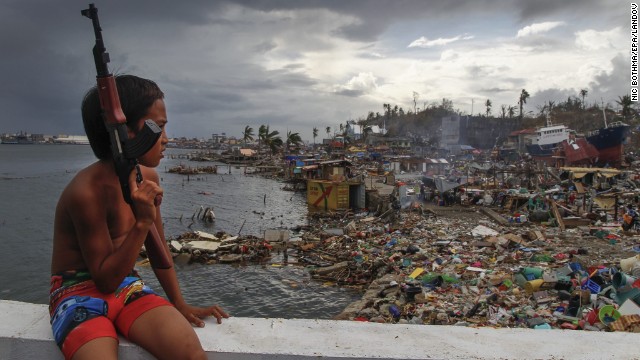
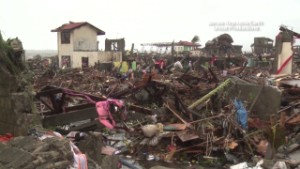

His day of work took a heavy mental toll.
"It was difficult for me," he said. "It was a really emotional experience."
The next day, he said, "When I celebrated the Eucharist, I broke down because of all the suffering I had seen."
Hundreds of survivors were taking refuge in the church compound, much of which withstood Super Typhoon Haiyan's ferocious winds and destructive storm surge.
Many of them asked the pastor how God could let such a calamity befall this predominantly Catholic city.
His response, he said, was to tell them that "God is not the cause of the suffering. God cannot prevent this. This is the work of nature."
But why it had to happen to Tacloban and its more than 200,000 residents, Father Bacaltos acknowledged, is "difficult to explain."
As the people who remain in this broken city attempt to come to terms with the catastrophe that engulfed them a week ago, religion is offering a degree of solace for some of those who have suffered incalculable losses.
It's also providing basic elements of community and support to residents of an area where local government ceased to fully function for several days and is still only slowly sputtering back into action.
In Santo Nino Church -- situated a few blocks north of Father Bacaltos' compound -- Joan Norcio, 26, sat on one of the wooden pews near the back, waiting for Mass to begin.
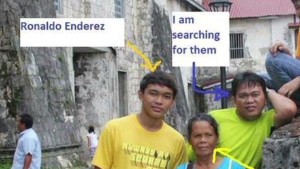
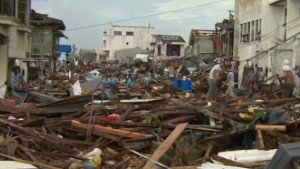
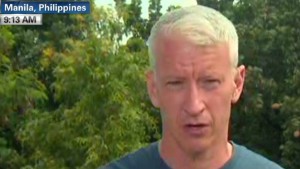
Her home has been destroyed, she said, and three members of her family are still missing. She's received no food from authorities, relying on the charity of her neighbors instead.
Attending Mass at Santo Nino has been "a big help" during this time, she said, sitting solemnly next to a motherly neighbor and the neighbor's young son.
The storm ripped off most of the roof of the church. A large pool of dirty water sits in the center of the floor. And the adoration chapel is filled with brown sludge and broken chairs.
But the altar is still largely intact. Masses resumed the day after the typhoon and are now being held two or three times a day, said Father Isagani Petilos, one of the two senior pastors at the church.
Father Petilos, who also blessed the bodies in the area surrounding his church soon after the storm, said he didn't know if religion was helping the survivors endure the aftermath.
"Only God knows," he said. "Only these people know. We are all victims. There are whole families lost."
He and his colleagues have encouraged people to write the names of those killed in the storm on a board, so that they can be included in the congregation's prayers.
Norcio said she has made use of another board at the back of the church where people can put details about missing loved ones in the hope that others who might know of their whereabouts can alert them.
Sitting a few rows farther forward, Arsenia Orioque, 74, had come to the church to pray and to take advantage of the medical services being offered there each afternoon.
Since the storm washed out her home and mini-grocery store, she has developed a bad cough, she said. All her clothes were ruined, leaving her to wear a red t-shirt that a neighbor took for her from a nearby shopping mall during the looting in the typhoon's aftermath.
She seldom came to church before the storm struck, but now she says she can find peace there.
"In my prayers, I give thanks that I survived the typhoon," she said.
In the Philippines, more than 80% of the population describes itself as Roman Catholic, and only a tiny fraction of those surveyed in the national census say they have no religion at all.
Many of Tacloban residents feel close to the nation's Catholic history. In 1521, the Portuguese explorer Ferdinand Magellan landed on Honmonhon Island, which sits on the Gulf of Leyte not far from Tacloban. Though he was eventually killed in a fight on another Philippine island, his arrival marked the beginning of the conversion of most of the archipelago to Catholicism.
The missionary spirit is alive and well in Father Bacaltos' chuch. It has provided food and shelter to more than 300 families since the storm, he said.

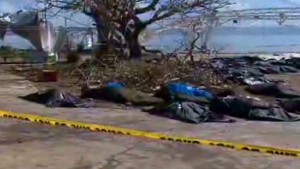

Inside the church, children played in the aisle and pieces of meat were cooking in a pan on a small fire.
Sitting shirtless on one pew with a cigarette in his mouth, Eddie Cinco disagreed with the pastor's view of the cause of the storm.
"It was an act of God," he said, a silver crucifix hanging from his neck and a wound gradually healing on his right arm. "Only God is strong enough to do this."
Rubbing one of his bare feet, he said that God had perhaps decided to punish Tacloban, but he couldn't think why.
Cinco said that he was thankful that he and his six family members staying in the church had been spared, even if their home had been flattened.
In his prayers, he said, he asks for no more calamities.
The churches are doing their best to help the living, but the dead are not being afforded a great deal of dignity - despite the pastors' initial efforts.
Corpses have lined the streets here for days, festering in plain view. Many of them are now encased in body bags, and workers are gradually collecting them and moving them to an outdoor morgue.
In front of the Church of Our Mother of Perpetual Help on Friday, a row of body bags was being hauled onto the back of a truck. Last in line was a rudimentary coffin with a wooden cross leaning against it.
Determining that the coffin wouldn't fit on the truck, the workers picked up the wooden cross and used it to smash open the lid. They pulled out the decaying bodies of a young woman and an older man, loosely wrapped in plastic, and deposited them on the road.
In front of a growing crowd, many of whom covered their noses with their hands or shirts, the workers placed the corpses in body bags and added them to the pile on the truck.
On the outskirts of town, bodies that hadn't been claimed by relatives who had to examine corpse after corpse at the morgue near the city hall were being lumped into mass graves.
There was no sign of religious rites at the proceedings. But Mayor Alfred Romualdez said a priest would conduct a ceremony at the mass graves, once the national authorities had given their approval.
Such grim scenes remain harrowingly abundant in and around Tacloban. But Father Petilos urged people not to focus only on the misery.
"Even if we have this kind of situation, there is still hope," he said, noting that some families in the city had begun the long, slow process of rebuilding their lives.
"Yes, we may have been damaged," he said. "Devastated. But we're not dead."
